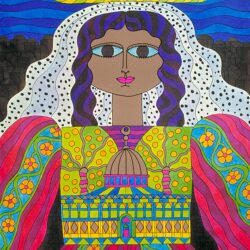International Women’s Day: Ann Demeulemeester on feathers, fashion and freedom

Inspired by rock 'n roll and punk, Ann Demeulemeester’s collections have always been designed with a strong story and a rebellious, free spirit. The frequent use of pigeon and cock feathers in her collections is an ode to the free spirit and the perfection of nature that human beings cannot match.


Have feathers always played an important role in your life and in your work?
Yes, since childhood, I have had a great respect for feathers, particularly dove feathers. For me, a dove feather represents the poetry of the ordinary: a sort of perfection that anyone can randomly find on the street.
The first time I saw my husband, Patrick Robyn, he was wearing a black blazer with a small grey dove feather in his breast pocket. I noticed it immediately. For me, that was so very attractive, and it never changed: still today, he always wears a small dove feather.
If I had to give this an absolute meaning, I would say that a feather is a symbol of freedom, a free spirit — the greatest luxury in life. For my first fashion show in Paris, for the 1992 spring/summer collection, I placed on each chair a leather string holding some dove feathers. A small metal plate with my name was attached to it. Some people still have this little chain — and it has been more than twenty years! I still have mine too; it is a sort of talisman.

Why dove feathers in particular? How do you decide which feathers you want to use for which piece?
I find dove feathers most attractive because they combine fragility, simplicity, and poetry. We humans can make so many beautiful things; however, we cannot compete with the perfection of such a feather. For my collection, I primarily choose rooster , dove, or duck feathers: simple, humble feathers. Sometimes, I have them painted. When I look at the beginning of my career, I have become better informed and I know better which type of plume I can find at each specific farm. I ask some farmers to keep specific feathers; I try to determine which forms and colours will suit a particular collection. Plumes are an integrated element in the creation of a collection. We do not decide at the end which feather will match the piece. Sometimes, I use a feather to add balance to a piece, because a feather adds tenderness to a harder image. The contrast between hard and soft gives my collections an overall sensibility. A collection never entails a one-sided romantic or hard feel — it must always have a soul; that is where feathers are so meaningful. The choice of a type of feather depends on the effect I want to obtain. Sometimes, I paint a dove and a rooster feather in the same colour; this highlights the differences between two types of plumes. A dove feather remains matte and somewhat grey with shades of red; the feather only absorbs part of the paint. A rooster feather is gleaming; colours are deeper with more black.


Have you developed new techniques over the years by using feathers?
In the beginning, I used feathers myself: for instance, we pierced small holes in the dove feathers and attached minuscule hooks. I would then plait the bustier together myself. Today, for larger pieces, we work with plumassiers in a workshop. For special pieces such as the headdress for PJ Harvey, I worked with milliner Elvis Pompillio. I literally showed him two bird wings and told him what I wanted: a headdress resembling a real bird. Together we brought the piece to life with a bag full of feathers. For the jewellery, I worked with a taxidermist who taught me how to shape little bird feet to cast them into bracelets, rings or necklaces. For instance, a dove leg clasped around your finger, raven legs as a necklace, or dove legs around a wrist. If you really want to do it, you can. You just have to want it badly enough, that’s my motto. When I want something, I simply do it. I have no fear. I would never make moulds from a feather, because I believe that you cannot improve a feather. Why make a copy in silver if you can use a real plume? I have too much respect for it to do that.
The emblematic necklace with a dove feather is in the collection every season and will be for years to come. There are variations, sometimes more intricate pieces, but the basis is always the dove plume. It is an important part of my world.


You have immense respect for birds and feathers. How do you combine this respect with the processing of each piece?
Whether for feathers or for any other animal material such as fur or leather, I only use natural materials when I can do no harm. In other words, I only use skins of animals (goats, sheep, etc.) that are already used for meat consumption. I use the same principle for feathers: they are residues from the poultry farmer; I do not have birds plucked. For feathers, it is the same as for other animal skins: we have reached a very high level with fake fur, mostly visual, but the sense of real fur cannot be recreated with artificial material. In a fur coat, you are never too hot or too cold; this material breathes and lives. We cannot perfect nature.


